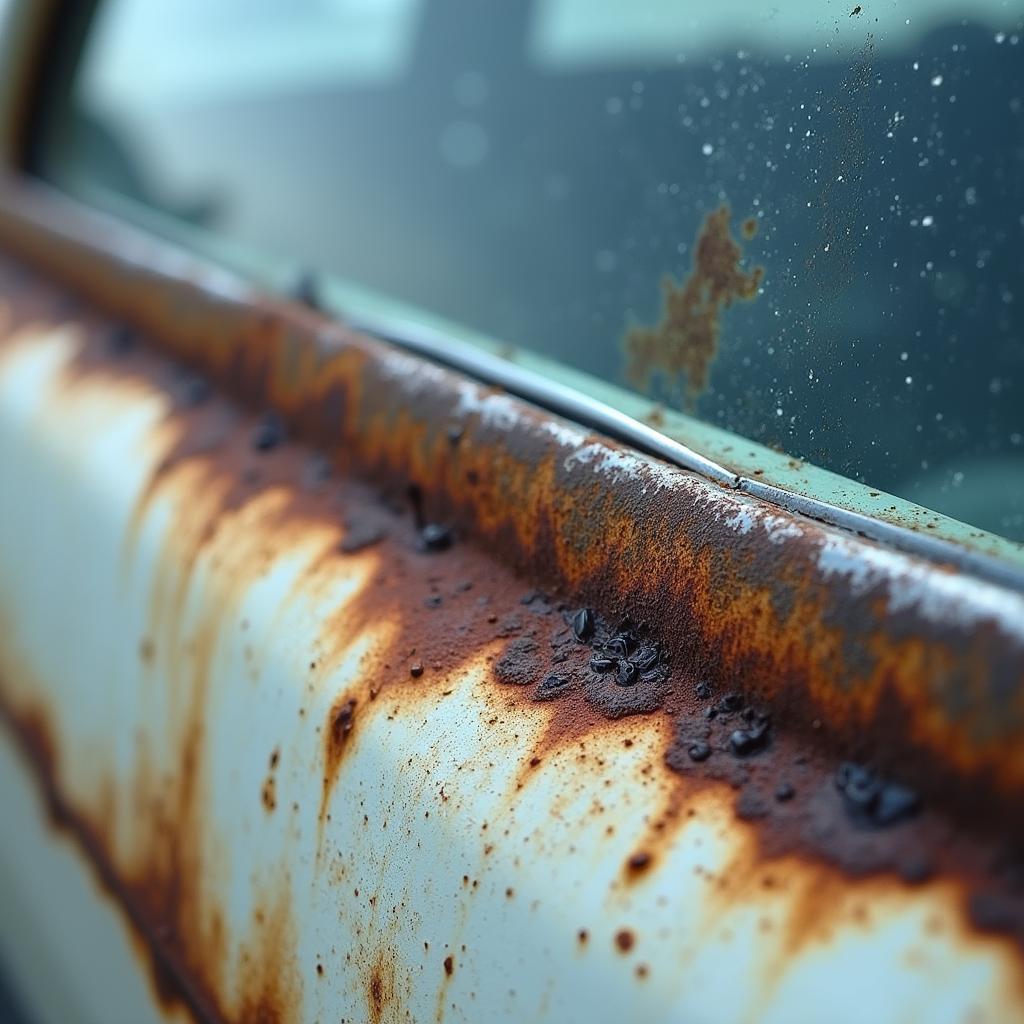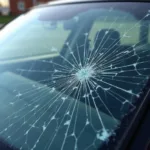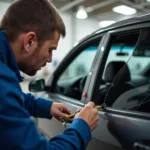Rust near your car window is more than just an eyesore; it can lead to serious structural damage if left untreated. Acting quickly is key to preventing the spread of rust and preserving your car’s value. This guide provides a comprehensive walkthrough on how to effectively repair rust by your car window, empowering you to tackle this common problem head-on.
Understanding the Enemy: Why Does Rust Form Near Car Windows?
Before we dive into the repair process, it’s helpful to understand why rust tends to develop around car windows in the first place. Here are the primary culprits:
- Moisture Traps: The window frame’s design often creates small crevices and gaps where moisture can collect. This trapped water becomes a breeding ground for rust.
- Scratched Paint: Even minor scratches or chips in the paint around your car window can expose the underlying metal to the elements, making it vulnerable to rust.
- Poor Drainage: Clogged sunroof drains or window seals can lead to water accumulation, increasing the risk of rust formation.
Assessing the Damage: Is it Surface Rust or Something More?
The repair approach depends on the severity of the rust.
- Surface Rust: This appears as light discoloration or bubbling of the paint. It hasn’t yet eaten into the metal and is relatively easy to treat.
- Scale Rust: This type of rust has progressed beyond the surface and appears as flakes or scales. It requires more extensive repair involving metal treatment.
- Penetrating Rust: This is the most severe form, where rust has eaten through the metal, creating holes. Professional repair is often necessary.
DIY Rust Repair: A Step-by-Step Guide
For surface and minor scale rust, you can often perform the repair yourself. Here’s what you’ll need:
- Safety Gear: Gloves, safety glasses, and a mask.
- Cleaning Supplies: Soap and water, rust remover, automotive primer, automotive paint (matching your car’s color), clear coat, rubbing compound, automotive wax.
- Tools: Sandpaper (various grits), masking tape, drop cloths, paintbrushes or a paint sprayer.
Steps:
- Preparation: Thoroughly wash the area around the rust with soap and water. Allow it to dry completely.
- Masking: Use masking tape and drop cloths to protect the surrounding areas from paint and debris.
- Rust Removal: Apply a rust remover gel or solution to the affected area, following the manufacturer’s instructions. This will help loosen and remove the rust.
- Sanding: Start with coarser grit sandpaper (80-120) to remove the bulk of the rust, then gradually move to finer grits (220-400) for a smooth finish.
- Priming: Apply a thin, even coat of automotive primer to the sanded area. Primer helps prevent future rust and provides a good surface for paint adhesion. Allow it to dry completely.
- Painting: Apply several thin coats of automotive paint that matches your car’s color. Allow each coat to dry before applying the next.
- Clear Coat: Once the paint is dry, apply a clear coat to protect it and enhance the shine.
- Finishing Touches: After the clear coat dries, use a rubbing compound to blend the edges and create a smooth transition. Finish with a coat of automotive wax for added protection.
When to Call a Professional
While DIY repairs can be effective for minor rust, more severe cases require professional expertise. Contact a qualified auto body shop if:
- The rust has penetrated the metal.
- The affected area is large or complex.
- You’re not comfortable performing the repair yourself.
Preventing Rust: Tips for Long-Term Protection
Prevention is always better than cure. Here are some proactive measures to keep rust at bay:
- Regular Washes: Frequently washing your car, especially during winter, helps remove salt and grime that can contribute to rust.
- Waxing: Applying a coat of wax every few months provides a protective barrier against the elements.
- Inspecting Seals: Regularly check your window seals and sunroof drains for any signs of damage or blockage.
- Addressing Scratches Promptly: Touch up any paint chips or scratches as soon as possible to prevent rust from taking hold.
Expert Insights
“Many car owners underestimate the importance of addressing rust early on,” says John Smith, a veteran auto body specialist with over 20 years of experience. “What might seem like a minor cosmetic issue can quickly escalate into a costly repair if ignored. Taking proactive steps to prevent and address rust is essential for maintaining your car’s value and longevity.”
By understanding the causes of rust, mastering the repair process, and adopting preventative measures, you can keep your car looking its best and protect your investment for years to come.
FAQs
Q: Can I use household paint to touch up rust spots?
A: No, it’s crucial to use automotive paint that’s specifically designed for use on vehicles. Household paint lacks the durability and protective properties of automotive paint.
Q: How long does it take for rust remover to work?
A: The time varies depending on the product and the severity of the rust. Always refer to the manufacturer’s instructions.
Q: Can I prevent rust from returning after repair?
A: While not entirely preventable, following the prevention tips outlined in this article can significantly reduce the risk of rust recurrence.
Q: Does car insurance cover rust repair?
A: Typically, car insurance only covers rust repair if it’s a result of a covered incident, like a collision. Rust caused by wear and tear is generally not covered.
Do you have a cracked or chipped car window? Find out more about DIY car window repair here: diy car window repair.
If you’re in the Indianapolis area and need professional assistance, check out our guide to car window repair in Indianapolis: car window repair indianapolis indiana.
Remember, addressing rust early and proactively is key to keeping your car in top shape. For all your car repair needs and expert advice, visit CarRepairOnline.



